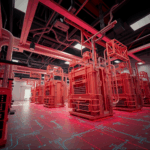
Is Your Construction R&D Strategy Sabotaging Innovation at Your Company?
What is your R&D investment doing for you?
While deciding exactly where and how to invest in digital innovation is tricky, savvy owners aren’t hesitating to explore new solutions that could drive efficiency across the building lifecycle and combine new streams of data for better decision-making.
At VIATechnik, we believe that when you honor the central role of data and make incremental investments in emerging technology today, you’ll see an outsized return on investment in the long term. Here, we’ll cover:
- Common innovation misconceptions
- Signs you should reconsider your innovation investment strategy
- How to leverage incremental innovation across the building lifecycle
- Three ways to kick off successful R&D
Common Innovation Misconceptions
The key to successful construction R&D is not to innovate for the sake of innovation, but to identify known problems and pain points that a digital investment can solve. While digital transformation may feel intimidating, you’ll be empowered and successful when you address these misconceptions head-on:
Misconception #1: R&D Is a Money Pit
R&D often gets the reputation of a loss leader — an investment area that is not profitable on its own merits. But in the property ownership space, R&D can be an effective profit driver.
Today’s leading digital investments are often directly tied to either savings for capital expenditures during construction (CapEx) or operating expenses for ongoing maintenance (OpEx), making the decision to invest in R&D crystal clear.
For instance, if you can calculate the savings new technology will bring to an initial build or to the monthly operating expenses of an existing facility, choosing what to implement and when becomes significantly more prescriptive than experimental.
Other times, the ROI and business impact of innovation are both less immediate — but still help move the needle when it comes to long-term business initiatives. Between 2014 and 2020, sustainability goals have caused the green building industry to grow by 55%, according to The Canadian Construction Association. And green construction practices aren’t just good for the environment: Scientific reports from studies as far away as Nigeria show that green innovation impacts levers like energy management that cumulatively have a positive impact on the bottom line.
Misconception #2: Digital Transformation Is Too Expensive
Well-known digital transformation consultants like McKinsey and Bain offer their services at exorbitantly high rates. But assuming that digital innovation is automatically too expensive is a mistake.
When you chop up your digital journey into incremental parts, it can be affordable for businesses of all sizes – and lead to invaluable rewards like reduced waste, greater efficiency, and worthwhile ROI.
Misconception #3: State-of-the-Art Is Not for Me
Cutting-edge technology that leverages AI/ML, AR, BIM, and Digital Twins isn’t just for the Apples and Amazons of the world. We often work with VIATechnik clients who are excited about state-of-the-art technology in theory, but don’t think they can apply it to their business today.
Instead of assuming a “We’re not ready” posture, empower your team members and vendors to consider how aspects of new technology could more effectively support your current business functions. Incremental improvements are still improvements; you do not need to adopt the most sophisticated version of a digital twin to gain immediate value.
Signs You Should Reconsider Your Innovation Investment Strategy
Designing, constructing, and operating buildings is a complex endeavor. While some surprises and hiccups are unavoidable, digital innovation can ease key pain points throughout the process.
If you find yourself facing the challenges below, it’s likely time to allocate R&D dollars toward innovation efforts that support a path toward Construction 4.0: the use of “interdisciplinary technologies that digitize, automate, and integrate the construction process at all stages of the value chain.” Here are the key issues:
- Transitions from one phase to another are always difficult. You see the same construction delays, cost overruns, and design issues over and over.
- OpEx budgets are not fully considered or planned for. You don’t blink at the cost of a $200 million healthcare tower, but your facilities managers can’t find the budget for unexpected adjustments like replacing a faulty air conditioning unit.
- External forces are impacting business requirements. You find yourself unprepared to adapt to changes in building code regulations, new ESG requirements, or the impact of artificial intelligence on your business.
- Buildings are not suited to current use cases. Your buildings are not optimized for how people want to use the space today. This includes office buildings that now house hybrid workforces, former restaurants used as ghost kitchens with no physical dining, or a data center that suddenly needs to comply with modern design standards.
Does this list feel all too familiar? Then it’s time to reimagine what data-based innovation could do for your current and future buildings. Investing in digital transformation now would help you eliminate surprises and predict future trends earlier so that you can make sound and timely decisions from start to finish.
How to Leverage Incremental Innovation Across the Building Lifecycle
At VIATechnik, we help clients understand what degree of digital transformation will benefit them and then work alongside them to put plans into action. We follow an approach we’ve nicknamed the SEE Framework, where we deliver digital transformation solutions that help clients move along a path of Strategy, Execution, and Enablement.
To select the right technology and apply it at the right focal points, you need a partner who completely understands your business processes, AEC as a whole, and the data, trends, and decisions that drive them both.
The following are specific examples of how owners can adopt incremental versions of innovative technology across the building lifecycle to improve efficiency and unlock new data-driven insights.
Design
In the earliest phase of planning a building, digital solutions can help you evaluate a piece of real estate to better determine what type of building should be built and how it should be designed.
Small Step: Owners leverage geospatial technology information systems like GIS to view and analyze geographic data in new ways. GIS can enhance BIM by integrating data like satellite imagery, aerial photography, digital elevation models, and social and economic data that provide a more holistic view of a project site and enable better decision-making.
Future Step: Once you harness the power of large data sources like GIS, find additional opportunities to deploy AI, set up time-saving automation, and leverage generative design practices.
Image source: https://summitenvcon.com/gis-services-3-d-modeling/
Construction
In the construction phase, BIM is already a powerful tool that allows stakeholders to input, manage, and share project-wide information in the form of dynamic information-rich models.
Small Step: Leverage 4D BIM to introduce the element of time to your models. By linking your construction schedule to BIM, you can animate it and turn it into a valuable video resource. A 3D BIM without a schedule may cause you to miss logistical and sequencing errors as you plan construction phases. When you add the fourth dimension of time, you can see project issues and insights that you otherwise wouldn’t.
Future Step: Advanced BIMs make it possible to employ intelligent scheduling, where data and AI automatically create optimized project schedules for you. The biggest benefit here is the opportunity for schedule compression; you could use AI optimization to find ways to take a 52-week project down to 46 weeks.
Hand-Off
The handover stage where a GC passes you the keys to a completed building is often unduly messy. The construction company is supposed to turn over all of the building data and all of the lessons learned — but often the owner’s team is handed a messy binder or USB stick that building operators don’t know what to do with.
Small Step: When you award a new building job to a construction team, talk about the handover expectations on day one so that everyone is on the same page. Be explicit about what the hand-off should contain and what the delivery format should look like.
Future Step: Adopt Digital Twin technology that replaces the hand-off of physical items and provides a data-rich digital duplicate of the building. The perk? Assuming your staff receives training, the Digital Twin can be seamlessly used by your operations and maintenance team members on day one — and for years to come.
Operations
For owners with an extensive portfolio of operational buildings, data is the holy grail that enables proactive and logical OpEx decisions.
Small Step: Invest in contextualized data that allows you to understand what assets you possess and where they are located. While this sounds very simplistic, at VIATechnik we regularly encounter facilities managers who don’t know the location of the nearest VAV unit, for example, and have to scrounge around for physical plans to find the answer. This should be information that your team members can find in just a few clicks.
Future Step: Expand your Digital Twin maturity to enable predictive technology. There is a wide range of Digital Twin functionality, and at VIATechnik we have outlined a Digital Twin maturity scale that ranges from 0–5. Predictive Digital Twins are more advanced and leverage AI/ML to send proactive alerts and warnings that prevent owners from spending more money than necessary on operating expenses.
Throughout every phase of the building process, you have the opportunity to start small today and unlock continuous improvement. By starting with incremental investments in innovative technology, you can collect more data, streamline every project’s efficiency, and watch savings snowball across every stage.
Three Ways to Kick Off Successful R&D
Feeling inspired to take a fresh look at your R&D strategy, but not sure where to begin? Start by identifying your high-level objectives, your existing data sources, and your ideal partners. Here’s what that looks like.
1. Identify Your Goals
First, leadership must determine the high-level goals that will guide innovation efforts. They don’t have to be granular or detailed, but identifying key themes is necessary to ensure that R&D efforts serve North Star goals.
Some common BIM goals are “connect siloed data” or “reduce the average time to opening day.” Once you’ve landed on a goal, you can work backward to put the right digital solutions in place.
2. Identify Existing Data Sources
Next, it’s important to do an internal audit of the existing data sources that power your business today.
- Where does data originate?
- Where does it flow to?
- How do various data repositories talk to one another?
- How do team members access them?
- Are they working in service of the goals you identified — and why or why not?
Answers to these questions will be vital as you figure out where your gaps and areas of digital transformation opportunity are hiding.
3. Identify the Right Partners
Finally, recognize that you need partners and vendors in place who value data and are willing to deploy it in service of your goals. Are they operating at the level of readiness that you need to advance? Do they have the ability to pursue greater sophistication in areas like BIM, Digital Twins, or generative design?
To test this, consider asking potential vendors this straightforward question:
“Can you describe how the data in your scope impacts at least two tangential scopes?”
Even if you pride yourself on having robust in-house resources, it’s impossible to do everything on your own. It’s wise to identify a range of partners who can guide your digital transformation journey and build and service your buildings.
Take Small Steps to Reap Big Rewards
Taking small steps towards state-of-the-art technology can deliver more than just incremental business value. We’re passionate about building out business cases and pilot programs at VIATechnik in partnership with owners to set the stage for exponential success.
You have many choices when it comes to where to begin and who to partner with. One thing you shouldn’t overthink is when to start. The time to invest in R&D that drives innovation and efficiency is now.
Start your digital journey today by hopping on a call with an AEC expert at VIATechnik this week. Contact us to book your call and discuss your custom roadmap.



